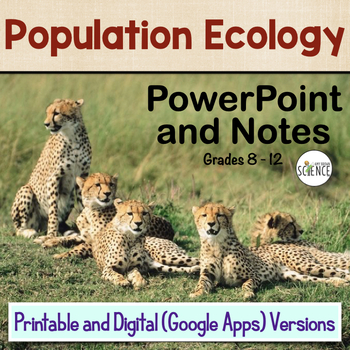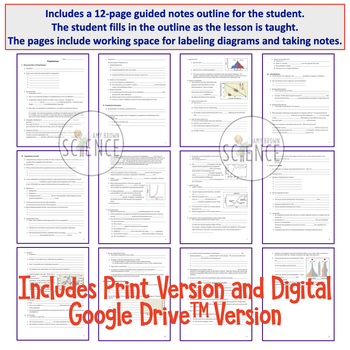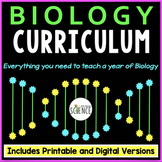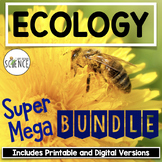Population Ecology PowerPoint and Notes
- Zip
- Google Apps™

What educators are saying
Also included in
- This "Population Ecology Unit Bundle" includes everything you need to teach a unit on population ecology to your life science, environmental science, or biology students. The bundle contains a 64-slide PowerPoint presentation with notes, a set of task cards, 2 labs, homework assignments, quizzes, tePrice $27.50Original Price $35.49Save $7.99
- This NO PREP, PRINTABLE, EDITABLE, AND DIGITAL Biology Curriculum contains everything you need for an entire year of Biology! For less than $3 a day, you can save your time, energy, and sanity. Each of the 20 Complete Units includes a teaching PowerPoint presentation, notes, labs, homework assignmenPrice $525.00Original Price $988.18Save $463.18
- All of my ecology and environmental science resources (6 ecology unit bundles) are included in this one Super-Mega-Bundle! This mega-bundle includes all of the PowerPoints, notes, labs, task cards, homework assignments, review games, quizzes, activities, and unit tests that you need to teach a compPrice $178.00Original Price $252.64Save $74.64
Description
This colorful and engaging PowerPoint presentation, "Population Ecology", will provide your students with interactive lessons on the ecological principles concerning populations. This is a 64-slide PowerPoint presentation and includes a set of lecture notes for the teacher and a note-taking outline for the students. Choose to use the traditional printable version, or the paperless, digital Google Apps version.
What is Included?
- 64-slide PowerPoint presentation (Includes traditional PowerPoint, PDF, and Google slides)
- Editable and Printable 9-page set of lecture notes for the teacher
- Editable and Printable 12-page guided notes outline for the student
- Paperless Digital Version for use in Google Drive, Google Classroom, and /or Microsoft OneDrive
This resource is perfect for distance learning and for students in 1:1 classrooms.
Ecology is one of the "must-teach" topics for any biology or life science class. The ecological inter-relationships that occur in nature are fundamental to an understanding of our world and how life interacts with the physical environment as well as with other living organisms. Ecology topics such as population growth dominate the news. We must make sure that our students are knowledgeable in these topics so they can be informed decision makers in the future.
This PowerPoint is on "Population Ecology". It consists of 64 slides that are colorful, informative and visually stimulating. Pictures and diagrams are included that will greatly enhance your instruction to your students. The use of eye-catching photos and diagrams rarely fails to stimulate a lively class discussion.
This resource also includes a set of notes for the teacher (9 pages) and an outline of the notes for the student (12 pages). Graphics, diagrams, clip art, and photographs were chosen to capture the attention of the student as the lesson is being taught. Students will use the outline as the PowerPoint is being presented and will fill in the notes as the lesson is being taught. I always include both the Word document and a pdf of the notes.
Topics covered in this lesson are:
- Characteristics of Populations: Definition of population, population size, geographic distribution, density, dispersion, growth rate, and age structure.
- Types of Dispersion: Clumped, even, and random, definitions and examples are given.
- Population Dynamics: Birth rate, death rate, life expectancy, age structure.
- Patterns of mortality: Survivorship Curves, the three types are defined and explained, examples given.
- Life Histories: Big-bang reproduction and repeated reproduction
- Population Growth: Growth rate, factors that determine the size of a population, migration, density, exponential growth, carrying capacity, limits to population growth, graphs of different types of population growth, logistic growth, assumptions of the exponential model and the logistic model.
- Carrying capacity and Logistic growth.
- Limits to Growth: Limiting factors, examples of limiting factors, density-dependent factors, competition, predation, parasitism, disease, territoriality, density independent factors.
- Human Population Growth: The history of human population growth, current human population growth, demographic transition, age-structure diagrams.
This PowerPoint was written with a typical biology I class in mind. It can easily be edited to meet your needs.
Related products include:
Introduction to Ecology PowerPoint with Notes for Teacher and Student
Community Ecology with Notes for Teacher and Student
Ecology Chat 2: Population Ecology
Ecosystems and the Biosphere Part 2: Biomes of the World PowerPoint and Notes
Human Impact on the Environment PowerPoint and Notes
FREE Set of Six Ecology Crossword Puzzles
FREE! Backyard Ecology: An Ecological Assessment of Your Back Yard
Population Ecology Quiz or Homework Practice
Population Ecology Homework Assignments / Study Guide
Population Ecology Review PowerPoint Q/A
Population Ecology Lab: The Wild Bean Population
Ecology Activity: Modeling Population Growth
For updates about sales and new products, please follow my store:
I would love to have you follow me at these locations as well:
My Blog: Amy Brown Science.com
Instagram: @AmyBrownScience








